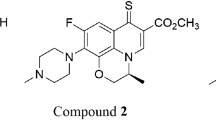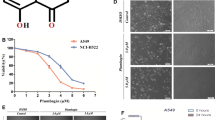Abstract
Previously, we reported the radiosensitizing potential of the combination of 2-deoxy-d-glucose (2DG) and ferulic acid (FA) in NCI-H460 non-small cell lung carcinoma cells in vitro. The present study aims to explore the relevant mechanism of cell death induced by the combination of 2DG and FA along with irradiation in NCI-H460 cells. Incubation of NCI-H460 cells with the combination of 2DG and FA for 24 h before irradiation upregulated the expression of proapoptotic proteins p53 and Bax. Combination of 2DG and FA also increased the levels of p21 and GADD45A in NCI-H460 cells. DNA repair inhibition is expected to be a possible mechanism for the radiosensitization observed, which is evidenced by the downregulation of radiation-induced ataxia-telangiectasia mutated gene expression upon treatment with 2DG and/or FA. Moreover, Western blotting analysis of NF-κB and caspase-3 revealed the involvement of apoptotic signals in the cytotoxicity exhibited by the combination of 2DG and FA. Cell cycle analysis data also showed the increased percentage of Sub-G0 phase cells upon treatment with the combination of 2DG and FA before irradiation. Taken together, the results of our study clearly suggested that the cell death induced by the combination of 2DG and FA along with irradiation would involve alteration in expression of p53, p21, NF-κB, Bax, and caspase-3, indicating oxidative mechanism in NCI-H460 cells.




Similar content being viewed by others
References
Molina JR, Yang P, Cassivi SD, Schild SE, Adjei AA. Non-small cell lung cancer: epidemiology, risk factors, treatment, and survivorship. Mayo Clin Proc. 2008;83(5):584–94.
Spira A, Ettinger DS. Multidisciplinary management of lung cancer. N Engl J Med. 2004;350(4):379–92.
Younes M, Brown RW, Stephenson M, Gondo M, Cagle PT. Over expression of Glut1 and Glut3 in stage I non small cell lung carcinoma is associated with poor survival. Cancer. 1997;80(6):1046–51.
Warburg O. On the origin of cancer cells. Science. 1956;123(3191):309–14.
Weber G. Enzymology of cancer cells. N Engl J Med. 1997;296(9):541–51.
Aft RL, Zhang FW, Gius D. Evaluation of 2-deoxy-d-glucose as a chemotherapeutic agent: mechanism of cell death. Br J Cancer. 2002;87(7):805–12.
Dwarakanath BS, Adhikari JS, Khaitan D, Chandna S, Mathur R, Ravindranath T. Growth inhibition and induction of apoptosis by 2-deoxy-d-glucose in human squamous carcinoma cell lines. Biomedicine. 2005;24:36–47.
Swamy RK, Manickam J, Adhikari JS, Dwarakanath BS. Glycolytic inhibitor, 2-deoxy-d-glucose, does not enhance radiation-induced apoptosis in mouse thymocytes and splenocytes in vitro. Indian J Exp Biol. 2005;43(8):686–92.
Nelson CA, Wang JQ, Leav I, Crane PD. The interaction among glucose transport, hexokinase, and glucose-6-phosphatase with respect to 3 H-2-deoxyglucose retention in murine tumor models. Nucl Med Biol. 1996;23(4):533–41.
Maher JC, Krishan A, Lampidis TJ. Greater cell cycle inhibition and cytotoxicity induced by 2-deoxy-d-glucose in tumor cells treated under hypoxic vs aerobic conditions. Cancer Chemother Pharmacol. 2004;53(2):116–22.
Heminger K, Jain V, Kadakia M, Dwarakanath B, Berberich SJ. Altered gene expression induced by ionizing radiation and glycolytic inhibitor 2-deoxy-glucose in a human glioma cell line: implications for radio sensitization. Cancer Biol Ther. 2006;5(7):815–23.
Coleman MC, Asbury CR, Daniels D, Du J, Aykin-Burns N, Smith BJ, et al. 2-deoxy-d-glucose causes cytotoxicity, oxidative stress, and radiosensitization in pancreatic cancer. Free Radic Biol Med. 2008;44(3):322–31.
Dwarkanath BS, Zolzer F, Chandana S, Bauch T, Adhikari JS, Muller WU, et al. Heterogeneity in 2-deoxy-d-glucose-induced modifications in energetics and radiation responses of human tumor cell lines. Int J Radiat Oncol Biol Phys. 2001;50(4):1051–61.
Lee KW, Lee HJ. The roles of polyphenols in cancer chemoprevention. Biofactors. 2006;26(2):105–21.
Garg AK, Buchholz TA, Aggarwal BB. Chemosensitization and radiosensitization of tumors by plant polyphenols. Antioxid Redox Signal. 2005;7(11–12):1630–47.
Trachootham D, Alexandre J, Huang P. Targeting cancer cells by ROS-mediated mechanisms: a radical therapeutic approach? Nat Rev Drug Discov. 2009;8(7):579–91.
Reddy BV, Prasad NR. 2-deoxy-d-glucose combined with ferulic acid enhances radiation response in non-small cell lung carcinoma cells. Cent Eur J Biol. 2011;6(5):743–55.
Levine AJ. p53, the cellular gatekeeper for growth and division. Cell. 1997;88(3):323–31.
Schmidt-Ullrich RK. Molecular targets in radiation oncology. Oncogene. 2003;22(37):5730–3.
Dent P, Yacoub A, Contessa J, Caron R, Amorino G, Valerie K, et al. Stress and radiation-induced activation of multiple intracellular signaling pathways. Radiat Res. 2003;159(3):283–300.
Iliakis G, Wang Y, Guan J, Wang H. DNA damage checkpoint control in cells exposed to ionizing radiation. Oncogene. 2003;22(37):5834–47.
Karin M, Cao Y, Greten F, Li Z. NF-kB in cancer: from innocent bystander to major culprit. Nat Rev Cancer. 2002;2(4):301–10.
Tsurutani J, Castillo SS, Brognard J, Granville CA, Zhang C, Gills JJ, et al. Tobacco components stimulate Akt-dependent proliferation and NFkappaB-dependent survival in lung cancer cells. Carcinogenesis. 2005;26(7):1182–95.
Leu TH, Maa MC. The molecular mechanisms for the antitumorigenic effect of curcumin. Curr Med Chem Anticancer Agents. 2002;2(3):357–70.
Rupinder SK, Gurpreet AK, Manjeet S. Cell suicide and caspases. Vasc Pharmacol. 2007;46(6):383–93.
Okouoyo S, Herzer K, Ucur E, Mattern J, Krammer PH, Debatin KM, et al. Rescue of death receptor and mitochondrial apoptosis signaling in resistant human NSCLC in vivo. Int J Cancer. 2004;108(4):580–7.
Weigel TL, Lotze MT, Kim PK, Amoscato AA, Luketich JD, Odoux C. Paclitaxel-induced apoptosis in non-small cell lung cancer cell lines is associated with increased caspase-3 activity. J Thorac Cardiovasc Surg. 2000;119(4 pt 1):795–803.
Krug LM, Miller VA, Filippa DA, Venkatraman E, Ng KK, Kris MG. Bcl-2 and bax expression in advanced non-small cell lung cancer: lack of correlation with chemotherapy response or survival in patients treated with docetaxel plus vinorelbine. Lung Cancer. 2003;39(2):139–43.
Porebska I, Wyrodek E, Kosacka M, Adamiak J, Jankowska R, Harłozińska-Szmyrka A. Apoptotic markers p53, Bcl-2 and Bax in primary lung cancer. In Vivo. 2006;20(5):599–604.
Sakata K, Someya M, Matsumoto Y, Hareyama M. Ability to repair DNA double-strand breaks related to cancer susceptibility and radiosensitivity. Radiat Med. 2007;25(9):433–8.
Xing J, Wu X, Vaporciyan AA, Spitz MR, Gu J. Prognostic significance of ataxia-telangiectasia mutated, DNA-dependent protein kinase catalytic subunit, and Ku heterodimeric regulatory complex 86-kD subunit expression in patients with non small cell lung cancer. Cancer. 2008;112(12):2756–64.
Livak KJ, Schmittgen TD. Analysis of relative gene expression data using real-time quantitative PCR and the 2-ΔΔCt method. Methods. 2001;25(4):402–8.
Lowry OH, Rosebrough NJ, Farr AL, Randall RJ. Protein measurement with the Folin phenol reagent. J Biol Chem. 1951;193(1):265–75.
Li L, Story M, Legerski R. Cellular responses to ionizing radiation damage. Int J Radiat Oncol Biol Phys. 2001;49(4):1157–62.
Zhang XD, Deslandes E, Villedieu M, Poulain L, Duval M, Gauduchon P, et al. Effect of 2-deoxy-d-glucose on various malignant cell lines in vitro. Anticancer Res. 2006;26(5A):3561–6.
Sinthupibulyakit C, Grimes KR, Domann FE, Xu Y, Fang F, Ittarat W, et al. p53 is an important factor for the radiosensitization effect of 2-deoxy-d-glucose. Int J Oncol. 2009;35(3):609–15.
Cao C, Shinohara ET, Subhawong TK, Geng L, Woon Kim K, Albert JM, et al. Radiosensitization of lung cancer by nutlin, an inhibitor of murine double minute 2. Mol Cancer Ther. 2006;5(2):411–7.
Desaint S, Luriau S, Aude JC, Rousselet G, Toledano MB. Mammalian antioxidant defenses are not inducible by H2O2. J Biol Chem. 2004;279(30):31157–63.
El-Deiry WS, Tokino T, Velculescu VE, Levy DB, Parsons R, Trent JM, et al. WAF1, a potential mediator of p53 tumor suppression. Cell. 1993;75(4):817–25.
Brugarolas J, Chandrasekaran C, Gordon JI, Beach D, Jacks T, Hannon GJ. Radiation-induced cell cycle arrest compromised by p21 deficiency. Nature. 1995;377(6549):552–7.
Zou C, Guan Y, Zou C, Wang J, Wang LE, Liebert M, Grossman HB, Wei Q. N-(4-hydroxyphenyl)retinamide (4-HPR) modulates GADD45 expression in radiosensitive bladder cancer cell lines. Cancer Lett. 2002;180(2):131–7.
Sheikh MS, Hollander MC, Fornace Jr AJ. Role of GADD45 in apoptosis. Biochem Pharmacol. 2000;59(1):43–5.
Saha A, Kuzuhara T, Echigo N, Fujii A, Suganuma M, Fujiki H. Apoptosis of human lung cancer cells by curcumin mediated through up-regulation of growth arrest and DNA damage inducible genes 45 and 153. Biol Pharm Bull. 2010;33(8):1291–9.
Haupt S, Berger M, Goldberg Z, Haupt Y. Apoptosis—the p53 network. J Cell Sci. 2003;116(20):4077–85.
Brady HJ, Salomons GS, Bobeldijk RC, Berns AJ. T cells from baxalpha transgenic mice show accelerated apoptosis in response to stimuli but do not show restored DNA damage-induced cell death in the absence of p53. EMBO J. 1996;15(6):1221–30.
Li CR, Zhou Z, Zhu D, Sun YN, Dai JM, Wang SQ. Protective effect of paeoniflorin on irradiation-induced cell damage involved in modulation of reactive oxygen species and the mitogen-activated protein kinases. Int J Biochem Cell Biol. 2007;39(2):426–38.
Zagorodna O, Martin SM, Rutkowski DT, Kuwana T, Spitz DR, Knudson CM. 2-Deoxyglucose-induced toxicity is regulated by Bcl-2 family members and is enhanced by antagonizing Bcl-2 in lymphoma cell lines. Oncogene 2011: Epub 2011 Oct 10.
Choudhuri T, Pal S, Agwarwal ML, Das T, Sa G. Curcumin induces apoptosis in human breast cancer cells through p53-dependent Bax induction. FEBS Lett. 2002;512(1–3):334–40.
Stecca C, Gerber GB. Adaptive response to DNA-damaging agents: a review of potential mechanisms. Biochem Pharmacol. 1998;55(7):941–51.
Rotman G, Shiloh Y. ATM: a mediator of multiple responses to genotoxic stress. Oncogene. 1999;18(45):6135–44.
Lavin M, Shiloh Y. Ataxia-telangiectasia: a multifaceted genetic disorder associated with defective signal transduction. Curr Opin Immunol. 1996;8(4):459–64.
Piret B, Schoonbroodt S, Piette J. The ATM protein is required for sustained activation of NF-kB following DNA damage. Oncogene. 1999;18(13):2261–71.
Chendil D, Ranga RS, Meigooni D, Sathishkumar S, Ahmed MM. Curcumin confers radiosensitizing effect in prostate cancer cell line PC-3. Oncogene. 2004;23(8):1599–607.
Lindholm PF, Bub J, Kaul S, Shidman VB, Kajdacsy-Balla A. The role of constitutive NF-kB activity in PC-3 human prostate cancer cell invasive behavior. Clin Exp Metastasis. 2000;18(6):471–9.
Nakayama H, Ikebe T, Beppu M, Shirasuna K. High expression levels of nuclear factor kappaB, IkappaB kinase alpha and Akt kinase in squamous cell carcinoma of the oral cavity. Cancer. 2001;92(12):3037–44.
Pajonk F, Pajonk K, McBride WH. Apoptosis and radiosensitization of Hodgkin cells by proteasome inhibition. Int J Radiat Oncol Biol Phys. 2000;47(4):1025–32.
Li N, Banin S, Ouyang H, Li GC, Courtois G, Shiloh Y, et al. ATM is required for IkappaB kinase (IKKk) activation in response to DNA double strand breaks. J Biol Chem. 2001;276(12):8898–903.
Higuchi K, Mitsuhashi N, Saitoh J, Maebayashi K, Sakurai H, Akimoto T, et al. Caffeine enhanced radiosensitivity of rat tumor cells with a mutant-type p53 by inducing apoptosis in a p53-independent manner. Cancer Lett. 2000;152(2):157–62.
Yu Q, La Rose JH, Zhang HL, Pommier Y. Antisense inhibition of Chk2/hCds1 expression attenuates DNA damage-induced S and G2 checkpoints and enhances apoptotic activity in HEK-293 cells. FEBS Lett. 2001;505(1):7–12.
Giammarioli AM, Gambardella L, Barbati C, Pietraforte D, Tinari A, Alberton M, et al. Differential effects of the glycolysis inhibitor 2-deoxy-d-glucose on the activity of pro-apoptotic agents in metastatic melanoma cells, and induction of a cytoprotective autophagic response. Int J Cancer 2011: Epub 2011 Sep 12.
Raffoul JJ, Wang Y, Kucuk O, Forman JD, Sarkar FH, Hillman GG. Genistein inhibits radiation-induced activation of NF-kB in prostate cancer cells promoting apoptosis and G2/M cell cycle arrest. BMC Cancer. 2006;6:107.
Chen HW, Huang HC. Effect of curcumin on cell cycle progression and apoptosis in vascular smooth muscle cells. Br J Pharmacol. 1998;124(6):1029–40.
Hou YZ, Yang J, Zhao GR, Yuan YJ. Ferulic acid inhibits vascular smooth muscle cell proliferation induced by angiotensin II. Eur J Pharmacol. 2004;499(1–2):85–90.
Mackey MA, Ianzini F. Enhancement of radiation-induced mitotic catastrophe by moderate hyperthermia. Int J Radiat Biol. 2000;76(2):273–80.
Acknowledgments
The financial assistance in the form of senior research fellowship to Mr. Bandugula Venkata Reddy, by the Indian Council of Medical Research, Government of India, New Delhi, is gratefully acknowledged. We greatly acknowledge Dr G. Prabavathi, radiation safety officer, GVN cancer hospital, Tiruchirapalli, India, for giving us technical assistance in handling irradiation facility.
Conflicts of interest
None
Author information
Authors and Affiliations
Corresponding author
Rights and permissions
About this article
Cite this article
Bandugula, V.R., N., R.P. 2-Deoxy-d-glucose and ferulic acid modulates radiation response signaling in non-small cell lung cancer cells. Tumor Biol. 34, 251–259 (2013). https://doi.org/10.1007/s13277-012-0545-6
Received:
Accepted:
Published:
Issue Date:
DOI: https://doi.org/10.1007/s13277-012-0545-6




